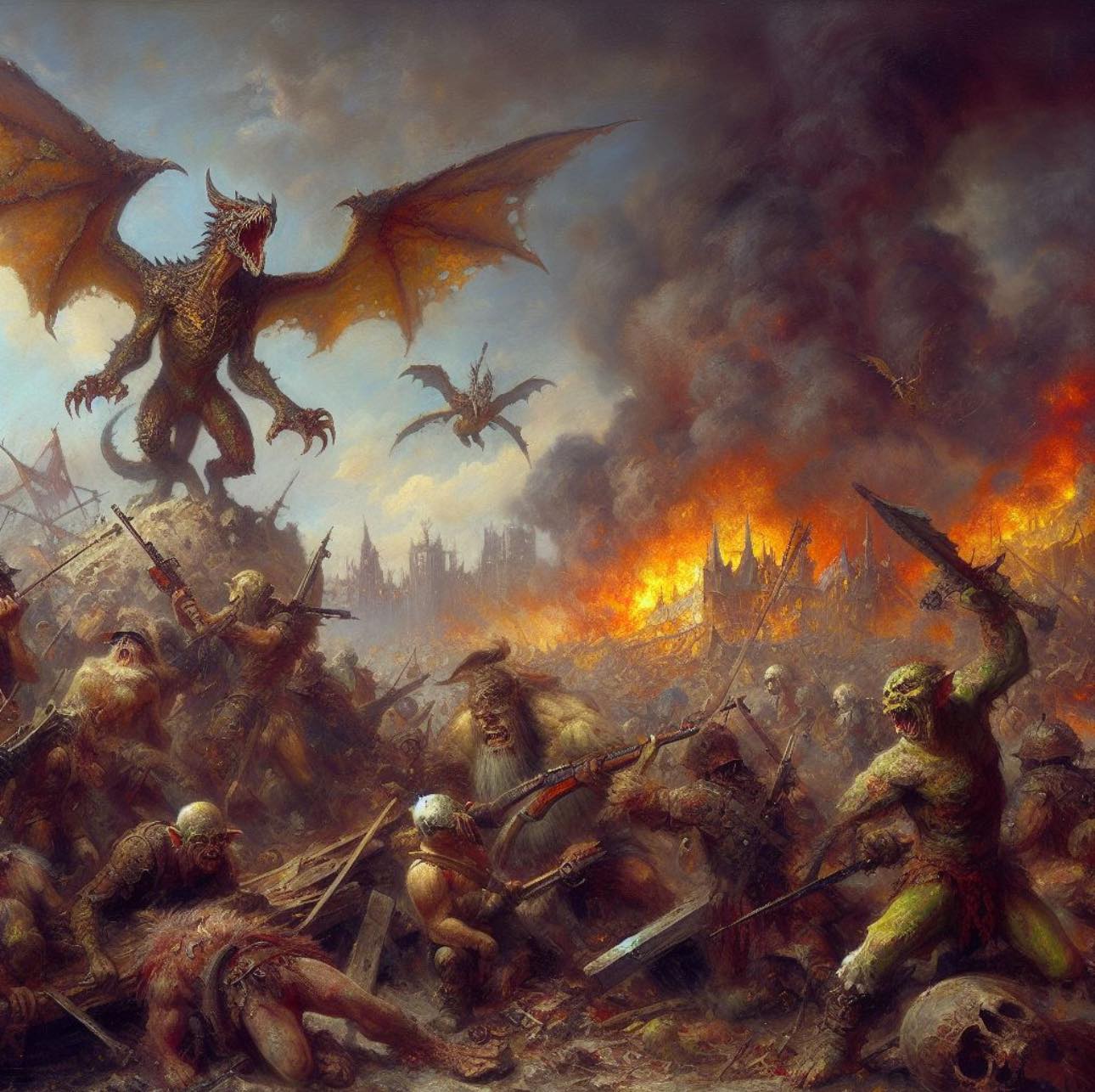"The Battle of Waldhaven, 1242"
By Eldrich Vance, 1785
Name: The Goblin Wars
Date: 18 May 965 – 20 November 1577
Location: Waldonia
The Waldonian Goblin Wars
The Waldonian Goblin Wars (965-1577), also known as the Second Great Goblin-Dragon War or simply The Goblin Wars, were a series of pivotal conflicts in Waldonia's early history, lasting several centuries, from the mid-10th century to the late 16th century. The wars were primarily fought between The Masters Council, a powerful supernatural order largely composed of dragons, and the local goblin population that had long inhabited the region. At the heart of these battles was the struggle for control over the land that would later become Waldonia, with the goblins fiercely resisting the civilizing influence of the Masters Council and their attempts to assert dominance.
The conflict began in the mid-10th century when the Masters Council established its headquarters in Widdlington, a burgeoning town rapidly becoming the center of political and magical influence in the region. The goblins, who had long inhabited the area, saw this move as a direct threat to their way of life. Following goblin raids on local villages and their refusal to accept the rules laid down by the council, the dragon-led army launched a series of skirmishes and war campaigns. Their goal was to solidify control over Waldonia's rich lands and resources and bring the goblins to heel.
One of the first major battles took place near Kaer Waldron Fortress, a strategically important location on Waldron Lake. Surrounded by water and nestled near the mountains, this fortress, originally built to protect early settlers from foreign invaders, became a key military stronghold for the dragons during the war. The goblins, fierce and tricky, fought with no qualms about dirty tactics, using their knowledge of the land and guerrilla warfare in the dense forests and rugged hills of Waldonia. However, their strength was often undermined by their fickleness and tendency to become easily distracted by their own hedonistic pleasures. In contrast, while fewer in number, the dragons were stronger, more disciplined, and relentless, keeping their forces tightly organized and focused on their goal. Over time, this contrast in strategy gave the dragons the upper hand, despite the heavy losses on both sides.
While Widdlington remained largely unscathed throughout the wars, smaller towns like Waldhaven and Yokelstedt were frequent battlegrounds. Goblin factions often launched raids against these settlements, both strategically located near key trade routes. Yokelstedt, in particular, became a symbol of goblin defiance after it fell to them in 1356. The sinister Baron Friedrich Von Hildendorf of the nearby castle forged an alliance with the invaders, and his estate would later serve as an unofficial headquarters for goblin leaders during the latter years of the conflict. Perched on the northeast of the Warpathian mountains, the estate became a formidable fortress, holding out against dragon forces for decades.
However, despite the goblins' tenacity, the tides of war shifted in favor of the dragons, particularly as infighting among the goblins escalated into a civil war. This allowed the Masters to launch an assault on the Yokelstedt region, culminating in The Battle for Worgo Pass. The battle proved decisive for the Masters, but not without tremendous sacrifice. Among the fallen was Master Alexander Devlin, an esteemed and revered dragon of the Masters Council. A veteran of countless battles, Devlin had become a symbol of leadership and unwavering resolve. His death, however, came as a cruel twist of fate—struck down by Widdle Frunkut, a cunning goblin leader who ambushed him with a treacherous attack during a moment of vulnerability, sealing the loss of one of the Masters' most respected figures. Devlin's heroic leadership had inspired many, but his death at the hands of Frunkut marked a sorrowful and bitter turning point in the war.
Following the reclaiming of Yokelstedt and its castle, many goblins fled deeper into the mountains, but their military forces never recovered. Baron Von Hildendorf was ultimately allowed to keep his estate despite his alliance with the goblins, though he was placed on probation by the Masters Council and compelled to attend a reeducation course.
With their defeat, most goblins gradually abandoned the region, retreating into the wilderness or relocating to other parts of the Waldoverse. Their departure marked the end of the Goblin Wars and the beginning of a new era for Waldonia. The Masters Council solidified its control, and Widdlington, with its growing influence, emerged as the heart of Waldonia's political and mystical life. Over time, the county of Waldoshire took shape, reflecting both the region’s rich history and the continued presence of magic, although the echoes of the Goblin Wars still lingered in the folklore and stories of the land.
